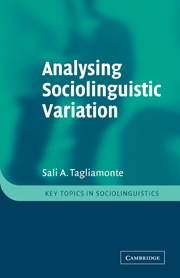Crossref Citations
This Book has been
cited by the following publications. This list is generated based on data provided by Crossref.
Rickford, John R.
Wasow, Thomas
Zwicky, Arnold
and
Buchstaller, Isabelle
2007.
INTENSIVE AND QUOTATIVEALL: SOMETHING OLD, SOMETHING NEW.
American Speech,
Vol. 82,
Issue. 1,
p.
3.
Hay, Jennifer
and
Drager, Katie
2007.
Sociophonetics.
Annual Review of Anthropology,
Vol. 36,
Issue. 1,
p.
89.
Kendall, Tyler
2008.
On the History and Future of Sociolinguistic Data.
Language and Linguistics Compass,
Vol. 2,
Issue. 2,
p.
332.
van Compernolle, Rémi A.
2008.
Morphosyntactic and phonological constraints on negative particle variation in French-language chat discourse.
Language Variation and Change,
Vol. 20,
Issue. 2,
p.
317.
TAGLIAMONTE, SALI A.
2008.
So different and pretty cool! Recycling intensifiers in Toronto, Canada.
English Language and Linguistics,
Vol. 12,
Issue. 2,
p.
361.
Nuessel, Frank
2008.
Review of Fought (2006): Language and Ethnicity.
Language Problems and Language Planning,
Vol. 32,
Issue. 2,
p.
208.
Hazen, Kirk
and
Hamilton, Sarah
2008.
A Dialect Turned Inside Out.
Journal of English Linguistics,
Vol. 36,
Issue. 2,
p.
105.
Anderson, Wendy
2008.
Corpus Linguistics in the UK: Resources for Sociolinguistic Research.
Language and Linguistics Compass,
Vol. 2,
Issue. 2,
p.
352.
Rau, D. Victoria
Chang, Hui‐Huan Ann
and
Tarone, Elaine E.
2009.
Think or Sink: Chinese Learners' Acquisition of the English Voiceless Interdental Fricative.
Language Learning,
Vol. 59,
Issue. 3,
p.
581.
Schembri, Adam
McKee, David
McKee, Rachel
Pivac, Sara
Johnston, Trevor
and
Goswell, Della
2009.
Phonological variation and change in Australian and New Zealand Sign Languages: The location variable.
Language Variation and Change,
Vol. 21,
Issue. 2,
p.
193.
CLARK, LYNN
and
TROUSDALE, GRAEME
2009.
Exploring the role of token frequency in phonological change: evidence from TH-Fronting in east-central Scotland.
English Language and Linguistics,
Vol. 13,
Issue. 1,
p.
33.
Lucchesi, Dante
N. Baxter, Alan
and
Ribeiro, Ilza
2009.
O Português Afro-Brasileiro.
Lucchesi, Dante
2009.
Dos sons às palavras: nas trilhas da Língua Portuguesa.
p.
84.
Johnson, Daniel Ezra
2009.
Getting off the GoldVarb Standard: Introducing Rbrul for Mixed‐Effects Variable Rule Analysis.
Language and Linguistics Compass,
Vol. 3,
Issue. 1,
p.
359.
Rendle-Short, Johanna
2009.
The Address TermMatein Australian English: Is it Still a Masculine Term?.
Australian Journal of Linguistics,
Vol. 29,
Issue. 2,
p.
245.
van Compernolle, Rémi A.
and
Williams, Lawrence
2009.
LEARNER VERSUS NONLEARNER PATTERNS OF STYLISTIC VARIATION IN SYNCHRONOUS COMPUTER-MEDIATED FRENCH.
Studies in Second Language Acquisition,
Vol. 31,
Issue. 3,
p.
471.
Buchstaller, Isabelle
2009.
The Quantitative Analysis of Morphosyntactic Variation: Constructing and Quantifying the Denominator.
Language and Linguistics Compass,
Vol. 3,
Issue. 4,
p.
1010.
Tagliamonte, Sali A.
and
Denis, Derek
2010.
The Stuff of Change: General Extenders in Toronto, Canada.
Journal of English Linguistics,
Vol. 38,
Issue. 4,
p.
335.
Dubenion-Smith, Shannon A.
2010.
Verbal Complex Phenomena in West Central German: Empirical Domain and Multi-Causal Account.
Journal of Germanic Linguistics,
Vol. 22,
Issue. 2,
p.
99.
Moore, Emma
2010.
Interaction between social category and social practice: explainingwas/werevariation.
Language Variation and Change,
Vol. 22,
Issue. 3,
p.
347.



